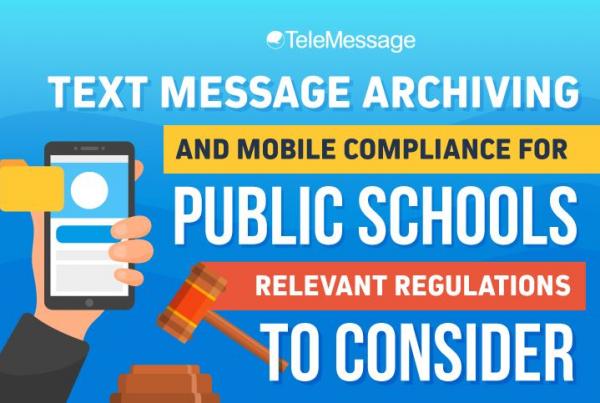Public schools have embraced text messaging as their channel of choice when communicating with staff, students, and parents. And since we first wrote about relevant regulations in the Text Message Archiving and Mobile Use in the Public Sector, the compliance requirements for using mobile SMS in the education sector have received more clarification.
As the regulations becoming more specific with their standards and expectations, compliance should no longer be as complicated an endeavor as before for school administrators. Failing to exercise the best practices alongside the implementation of the right technology, though, could still lead to dire consequences. On the other hand, being able to comply with privacy and recordkeeping standards could help schools identify unprofessional behaviors by their staffs and take legal action to ensure legal and regulatory compliance.
Just recently, an FOIA request from two media group revealed that the principal of Hilton Head High School and now-former Beaufort County Sheriff’s Office Deputy used text messaging to exchange potentially sensitive information about their workplaces, including information about students, district personnel, as well as messages from co-workers.
This recent case clarifies how important it is for public schools to use text messaging and other mobile communications channels in compliance with the privacy and recordkeeping regulations in place. Following are some of the best practices public schools can implement to meet privacy and archiving standards when using text messaging.
Obtain Express Written Consent
As mentioned previously, unless it’s for emergencies, the TCPA prohibits schools from sending text messages without the prior consent of the recipient. This basically means that before you can send texts to your students or parents, you must obtain their “express written consent,” which they can provide through the following methods:
- Sending a keyword or
- Entering their phone number on an online form in your website.
- Signing up at your school facility.
When they provide their opt-in through a text message, make sure that you document those by capturing and recording them as well. Doing so will enable you to provide proof that they have agreed to receive general text messages from your organization.
Include a Concise Call to Action
A call to action (CTA) is the message that prompts the individual — for example, parents to subscribe to your SMS services. It should detail:
- the purpose of the service
- how often they can expect to receive texts from you
- the message and data rates that they may incur if they sign up
- and the terms and conditions of your service
Provide Students and Parents the Option to Opt-Out
Once you’ve received the express written consent from your constituents, make sure that you send them a text which details how they can unsubscribe from your text messaging service. The directions on how they can opt-out should be easy and straightforward, for example, “Reply STOP to unsubscribe.”
Establish a Text Messaging Policy in the Workplace
Teachers texting students and vice versa is a common sight in most schools today. While now the norm, it’s still important for school administrators to make sure that their academic staff, as well as back-office employees, use text messaging in a way that abides by relevant rules, such as Family Educational Rights and Privacy Act (FERPA) and Open Records Laws/FOIA.
The text messaging policy should:
- require teachers to use mobile SMS only to communicate school-related messages with their students
- report any inappropriate messages teachers might receive from students
- and inform the parents about the school performance of their children only when necessary.
The policy should also clearly express that all the text messages received and responded to by all school officials and personnel – regardless of device ownership or network – are captured and archived. This can effectively curb any attempt to use the channel to communicate irrelevant or malicious messages to students.
Use Technology to Capture and Record Mobile SMS
There are many vendors offering platforms for archiving text messages. However, you must make sure that the one you’ll choose is not only offering a platform but a solution that will not only help you remain compliant with relevant archiving laws but also with privacy laws as well.
This means that the vendor of your choice should be able to capture and record mobile SMS of your employees and personnel in real-time and transmit those messages to your archiving vendor of choice securely as well. A vendor with that capability will help ensure that all your archived text messages, especially those that include information about your students, are protected from potential hacking and data breach.
With TeleMessage Mobile Archiver, public schools can effectively satisfy their compliance, regulatory, and eDiscovery obligations and reduce risks of using text messaging when communication with the staff, students and parents.
Our Mobile Archiver captures and records mobile content, including SMS, MMS, voice calls, social media, and WhatsApp Chats from corporate or BYOD mobile phones. Messages are securely and reliably retained within TeleMessage servers or forwarded to an archiving data storage vendor of your choice.
Our mobile archiving products securely capture content from mobile carriers and mobile devices for a variety of ownership models (BYOD, CYOD, and employer-issued). With our multiple archiving methods, you can always find the right tools or blend for your text message archiving and voice call recording requirements:
TeleMessage offers cross-carrier and international mobile text and calls archiving for Corporate and BYOD phones. Contact us today to learn more about how we can help your educational institution stay compliant with text archiving regulations.


